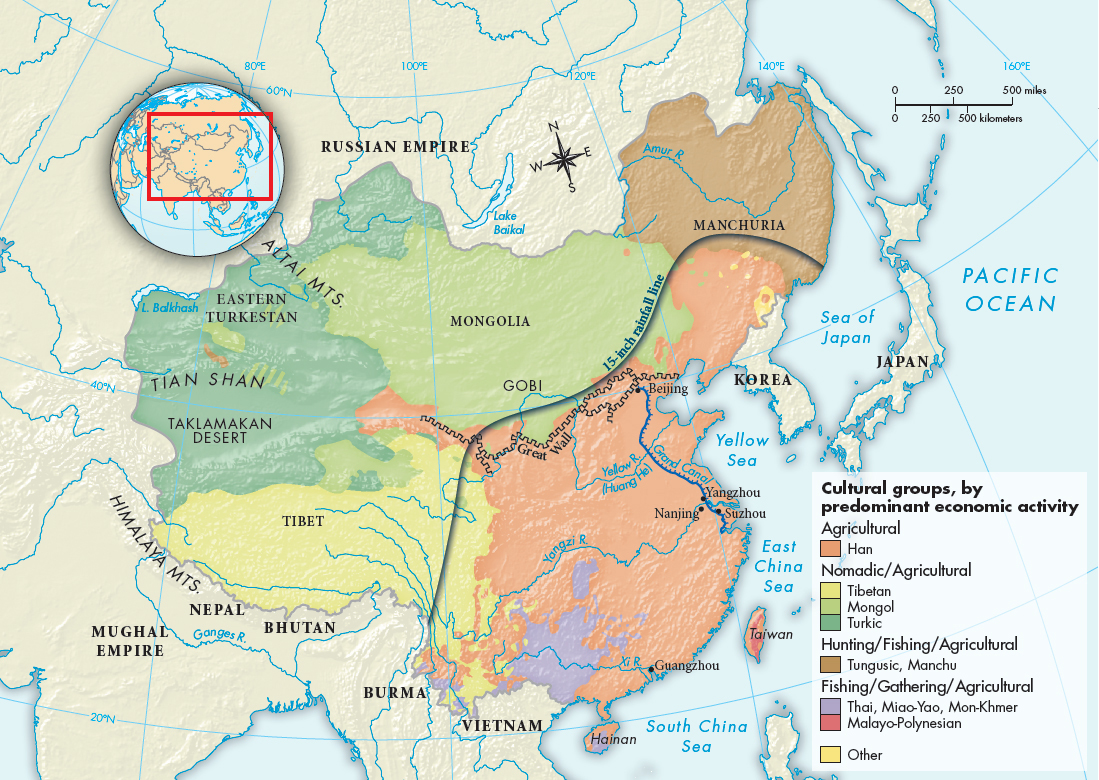A History of World Societies:
Printed Page 627
A History of World Societies Value
Edition: Printed Page 630
Chapter Chronology
The Rise of the Manchus
In the Ming period, the Manchus lived in dispersed communities in what is loosely called Manchuria (the northeast of modern-day China). In the more densely populated southern part of Manchuria, the Manchus lived in close contact with Mongols, Koreans, and Chinese (Map 21.1). They were not nomads but rather hunters, fishers, and farmers. Like the Mongols, they also were excellent horsemen and archers and had a strongly hierarchical social structure, with elites and slaves. Slaves, often Korean or Chinese, were generally acquired through capture. A Korean visitor described many small Manchu settlements, most no larger than twenty households, supported by fishing, hunting for pelts, collecting pine nuts or ginseng, or growing crops such as wheat, millet, and barley. Villages were often at odds with each other over resources, and men did not leave their villages without arming themselves with bows and arrows or swords. Interspersed among these Manchu settlements were groups of nomadic Mongols who lived in tents.

Mapping the PastMAP 21.1 The Qing Empire, ca. 1800 The sheer size of the Qing Empire in China almost inevitably led to its profound cultural influence on the rest of Asia.ANALYZING THE MAP How many different cultural groups are depicted? Which occupied the largest territories? Where was crop agriculture most prevalent?CONNECTIONS What geographical and political factors limited the expansion of the Qing Empire?
The Manchus credited their own rise to Nurhaci (1559–1626). Over several decades, he united the Manchus and expanded their territories. Like Chinggis Khan, who had reorganized the Mongol armies to reduce the importance of tribal affiliations, Nurhaci created a new social basis for his armies in units called banners. Each banner was made up of a set of military companies and included the families and slaves of the soldiers. Each company had a hereditary captain, often from Nurhaci’s own lineage. Over time new companies and new banners were formed, and by 1644 there were eight each of Manchu, Mongol, and Chinese banners. When new groups were defeated, their members were distributed among several banners to lessen their potential for subversion.
The Manchus entered China by invitation of the distinguished Ming general Wu Sangui, himself a native of southern Manchuria, who was near the eastern end of the Great Wall when he heard that the rebels had captured Beijing. The Manchus proposed to Wu that they join forces and liberate Beijing. Wu opened the gates of the Great Wall to let the Manchus in, and within a couple of weeks they occupied Beijing. When the Manchus made clear that they intended to conquer the rest of the country and take the throne themselves, Wu and many other Chinese generals joined forces with them. Before long, China was again under alien rule.
In the summer of 1645 the Manchus ordered all Chinese serving in Manchu armies to shave the front of their heads in the Manchu fashion, presumably to make it easier to recognize whose side they were on. Soon this order was extended to all Chinese men. Because so many of those newly conquered by the Qing refused to shave off their hair, Manchu commanders felt justified in ordering the slaughter of defiant cities. After quelling resistance, the Qing put in place policies and institutions that gave China a respite from war and disorder. Most of the political institutions of the Ming Dynasty were taken over relatively unchanged, including the examination system.
After peace was achieved, population growth took off. Between 1700 and 1800 the Chinese population seems to have nearly doubled, from about 150 million to over 300 million. Population growth during the eighteenth century has been attributed to many factors: global warming that extended the growing season, expanded use of New World crops, slowing of the spread of new diseases that had accompanied the sixteenth-century expansion of global traffic, and the efficiency of the Qing government in providing relief in times of famine.
Some scholars have recently argued that China’s overall standard of living in the mid-eighteenth century was comparable to Europe’s and that the standards of China’s most developed regions, such as the lower Yangzi region, compared favorably to the most developed regions of Europe at the time, such as England and the Netherlands. Life expectancy, food consumption, and even facilities for transportation were at similar levels.
